The Source and Significance of Silicon in the Late Permian Dalong Formation, Northeastern Sichuan Basin
Abstract
1. Introduction
2. Geological Background
3. Materials and Methods
4. Results
5. Discussion
5.1. Origin of Siliceous Rocks
5.2. Sedimentary Tectonic Background of the Dalong Formation
5.3. Influence of Hydrothermal Activity on Organic Matter Enrichment
6. Conclusions
Supplementary Materials
Author Contributions
Funding
Data Availability Statement
Acknowledgments
Conflicts of Interest
References
- Cao, T.T.; Song, Z.G.; Wang, S.B.; Cao, X.; Li, Y.; Xia, J. Characterizing the pore structure in the Silurian and Permian shales of the Sichuan Basin, China. Mar. Pet. Geol. 2015, 61, 140–150. [Google Scholar] [CrossRef]
- Wei, Z.F.; Wang, Y.L.; Wang, G.; Sun, Z.; Xu, L. Pore characterization of organic-rich Late Permian Da-long Formation shale in the Sichuan Basin, southwestern China. Fuel 2018, 211, 507–516. [Google Scholar] [CrossRef]
- Wang, R.Y.; Hu, Z.Q.; Dong, L.; Gao, B.; Sun, C.; Yang, T.; Wang, G.; Yin, S. Advancement and trends of shale gas reservoir characterization and evaluation. Oil Gas Geol. 2021, 42, 54–65. [Google Scholar]
- Fang, S.Y. Middle-Upper Permian Siliceous Rocks in Lower Yangtze Area Origin and Shale Gas Potential. Master’s Thesis, Nanjing University, Nanjing, China, 2021. [Google Scholar]
- Xu, Y.T. Genetic geochemistry for the bedded silicalite in the late permian Dalong formation and its sedimehtary setting in Southeastern Hubei. J. Guilin Inst. Technol. 1997, 17, 204–212, (In Chinese with English Abstract). [Google Scholar]
- Li, F.; Liu, Z.J.; Chen, F.R.; Wei, F.B.; Guo, J.C.; Su, Z.X. Origin of siliceous mudstone in Permian Dalong Formation and its influence on compressibility, Northeastern Sichuan Basin. Nat. Gas Geosci. 2023, 34, 349–358, (In Chinese with English Abstract). [Google Scholar]
- Fang, X.; Zhou, Y.Q.; Yao, X.; Liu, M.C.; Liu, J.Z. Geochemical characteristics and petrogenesis of siliceous rocks from Shansi section, Guangyuan, Sichuan Province. Miner. Pet. 2017, 37, 93–102, (In Chinese with English Abstract). [Google Scholar]
- Yang, Y.C. Research on Geochemical Characteristics and Formative Factors of Cherts in the Dalong Formation of the Shangjianggou Area, Northwestern Sichuan Basin. Master’s Thesis, Chengdu University of Technology, Chengdu, China, 2015. [Google Scholar]
- Mei, S.; Henderson, C.M. Evolution of Permian conodont provincialism and its significance in global correlation and paleoclimate implication. Palaeogeogr. Palaeoclimatol. Palaeoecol. 2001, 170, 237–260. [Google Scholar] [CrossRef]
- Wignall, P.B.; Hallam, A.; Lai, X.; Yang, F. Palaeoenvironmental changes across the Permian/Triassic boundary at Shangsi (N. Sichuan, China). Hist. Biol. 1995, 10, 175–189. [Google Scholar] [CrossRef]
- Luo, J.X.; He, Y.B. Anoxic environments of the Permian of Middle and Upper Yangtze Area. J. Palaeogeogr. 2011, 13, 11–20, (In Chinese with English Abstract). [Google Scholar]
- Shellnutt, J.G.; Denyszyn, S.W.; Mundil, R. Precise age determination of mafic and felsic intrusive rocks from the Permian Emeishan large igneous province (SW China). Gondwana Res. 2012, 22, 118–126. [Google Scholar] [CrossRef]
- Tribovillard, N.; Algeo, T.J.; Lyons, T.; Riboulleau, A. Trace metals as paleoredox and paleoproductivity proxies: An update. Chem. Geol. 2006, 232, 12–32. [Google Scholar] [CrossRef]
- Murray, R.W. Chemical criteria to identify the depositional environment of chert: General principles and applications. Sediment. Geol. 1994, 90, 213–232. [Google Scholar] [CrossRef]
- Adachi, M.; Yamamoto, K.; Sugisaki, R. Hydrothermal chert and associated siliceous rocks from the northern Pacific: Their geological significance as indication of ocean ridge activity. Sediment. Geol. 1986, 47, 125–148. [Google Scholar] [CrossRef]
- Boström, K.; Peterson, M.N.A. The origin of aluminum-poor ferromanganoan sediments in areas of high heat flow on the East Pacific Rise. Mar. Geol. 1969, 7, 427–447. [Google Scholar] [CrossRef]
- De Baar, H.J.W.; Bacon, M.P.; Brewer, P.G.; Bruland, K.W. Rare earth elements in the Pacific and Atlantic Oceans. Geochim. Cosmochim. Acta 1985, 49, 1943–1959. [Google Scholar] [CrossRef]
- Michard, A.; Albarède, F.; Michard, G.; Minster, J.F.; Charlou, J.L.; Albar, F. Rare-earth elements and uranium in high-temperature solutions from East Pacific Rise hydrothermal vent field (13° N). Nature 1983, 303, 795–797. [Google Scholar] [CrossRef]
- Kimata, M. The crystal structure of non-stoichiometric Eu-anorthite: An explanation of the Eu-positive anomaly. Mineral. Mag. 1988, 52, 257–265. [Google Scholar] [CrossRef][Green Version]
- Michard, A. Rare earth element systematics in hydrothermal fluids. Geochim. Cosmochim. Acta 1989, 53, 745–750. [Google Scholar] [CrossRef]
- Murray, R.W.; Buchholtz Ten Brink, M.R.; Gerlach, D.C.; Russ, G.P., III; Jones, D.L. Rare earth, major, and trace elements in chert from the Franciscan Complex and Monterey Group, California: Assessing REE sources to fine-grained marine sediments. Geochim. Cosmochim. Acta 1991, 55, 1875–1895. [Google Scholar] [CrossRef]
- Goldberg, E.D.; Koide, M.; Schmitt, R.A.; Smith, R.H. Rare-earth distributions in the marine environment. J. Geophys. Res. 1963, 68, 4209–4217. [Google Scholar] [CrossRef]
- Turner, D.R.; Whitfield, M.; Dickson, A.G. The equilibrium speciation of dissolved components in freshwater and sea water at 25 °C and 1 atm pressure. Geochim. Cosmochim. Acta 1981, 45, 855–881. [Google Scholar] [CrossRef]
- Baker, R.A. Trace inorganics in water. In Neutron Activation Analysis of Lanthanide Elements in Sea Water; Høgdahl, O.T., Melsom, S., Bowen, V.T., Eds.; Jenne E A: Washington, DC, USA, 1968; pp. 308–325. [Google Scholar]
- Klinkhammer, G.; Elderfield, H.; Hudson, A. Rare earth elements in seawater near hydrothermal vents. Nature 1983, 305, 185–188. [Google Scholar] [CrossRef]
- Ge, X.T.; Chen, D.Z.; Zhang, G.J.; Huang, T.; Liu, M.; El-Shafeiy, M. Marine redox evolution and organic accumulation in an intrashelf Basin, NE Sichuan Basin during the Late Permian. Mar. Pet. Geol. 2022, 140, 105633. [Google Scholar] [CrossRef]
- Holland, H.D. The Chemistry of the Atmosphere and Oceans; Wiley: New York, NY, USA, 1978. [Google Scholar]
- McLennan, S.M.; Taylor, S.R.; Kröner, A. Geochemical evolution of Archean shales from South Africa. I. The Swaziland and Pongola Supergroups. Precambrian Res. 1983, 22, 93–124. [Google Scholar] [CrossRef]
- Bhatia, M.R.; Crook, K.A.W. Trace element characteristics of graywackes and tectonic setting discrimination of sedimentary basins. Contrib. Mineral. Petrol. 1986, 92, 181–193. [Google Scholar] [CrossRef]
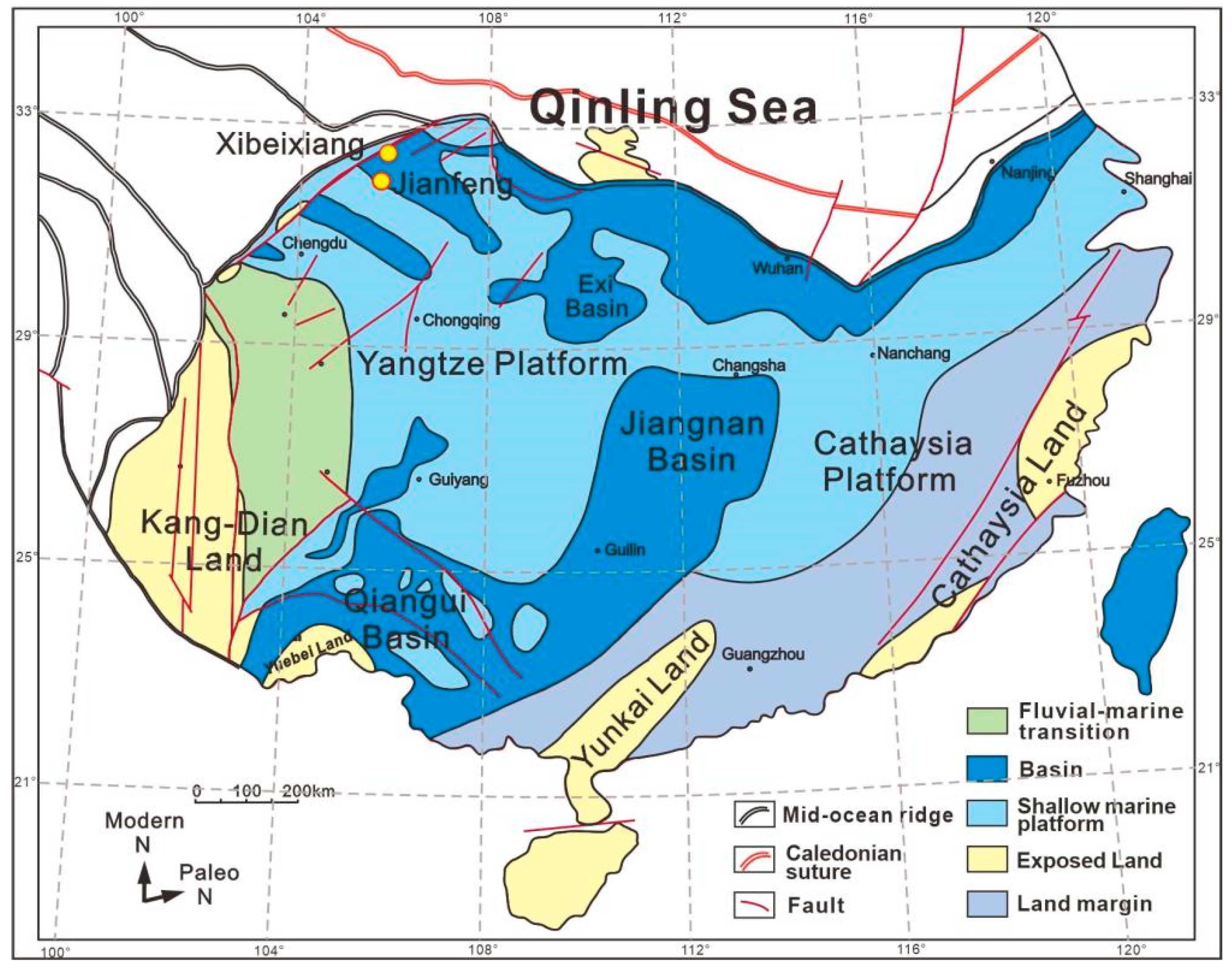

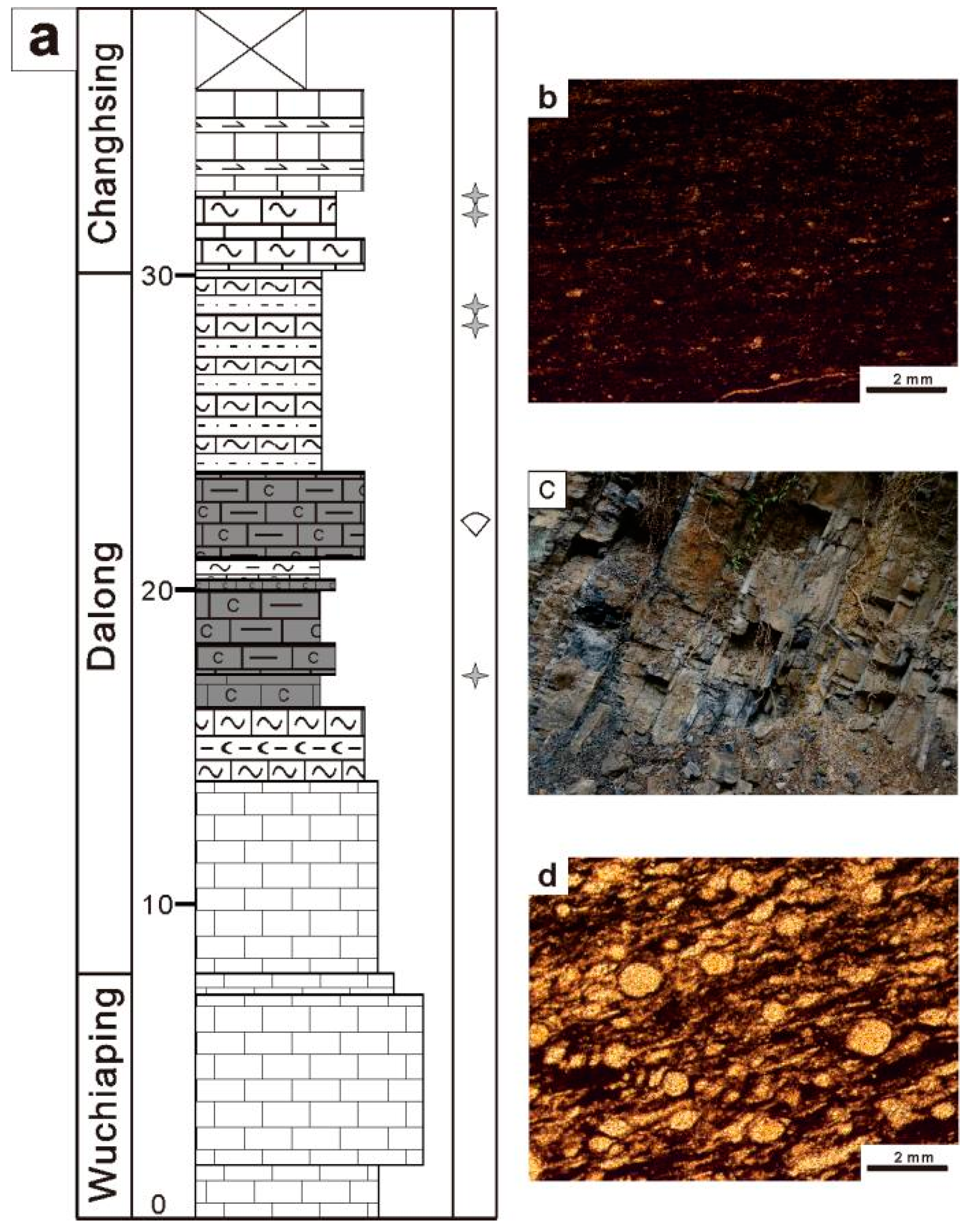
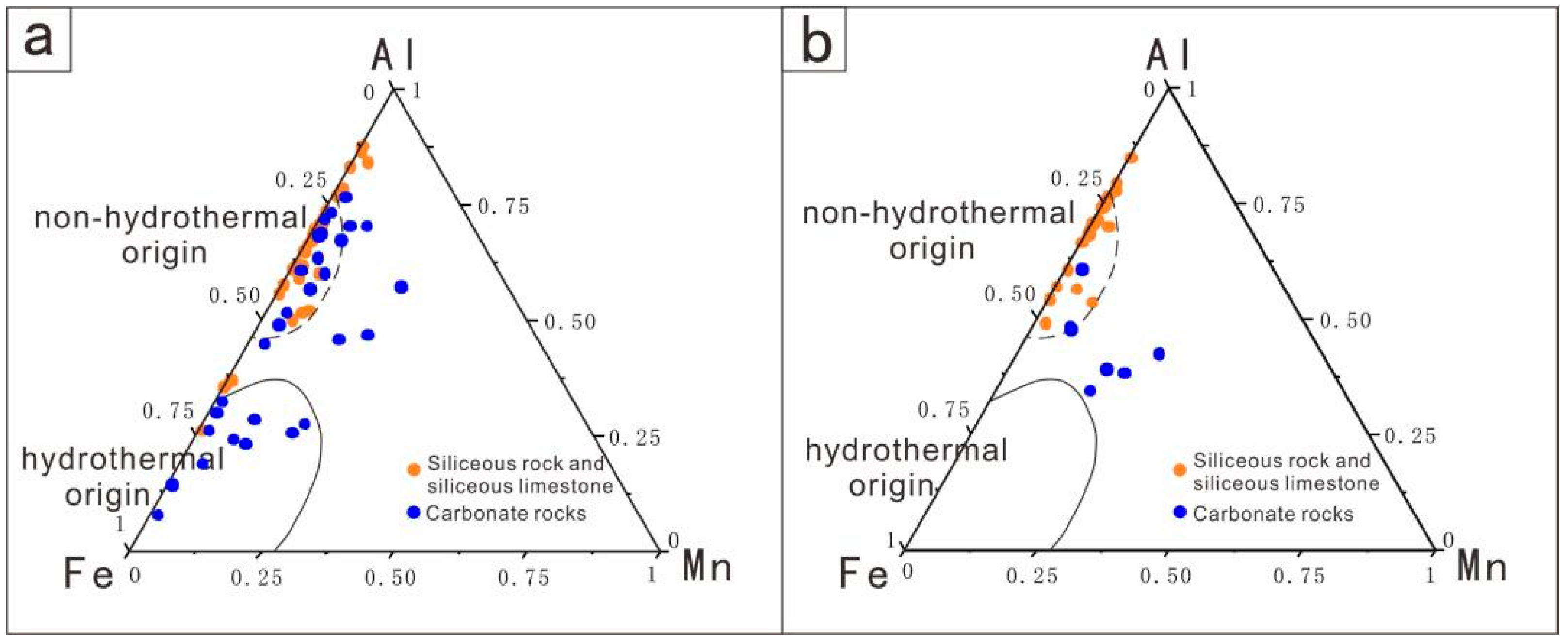
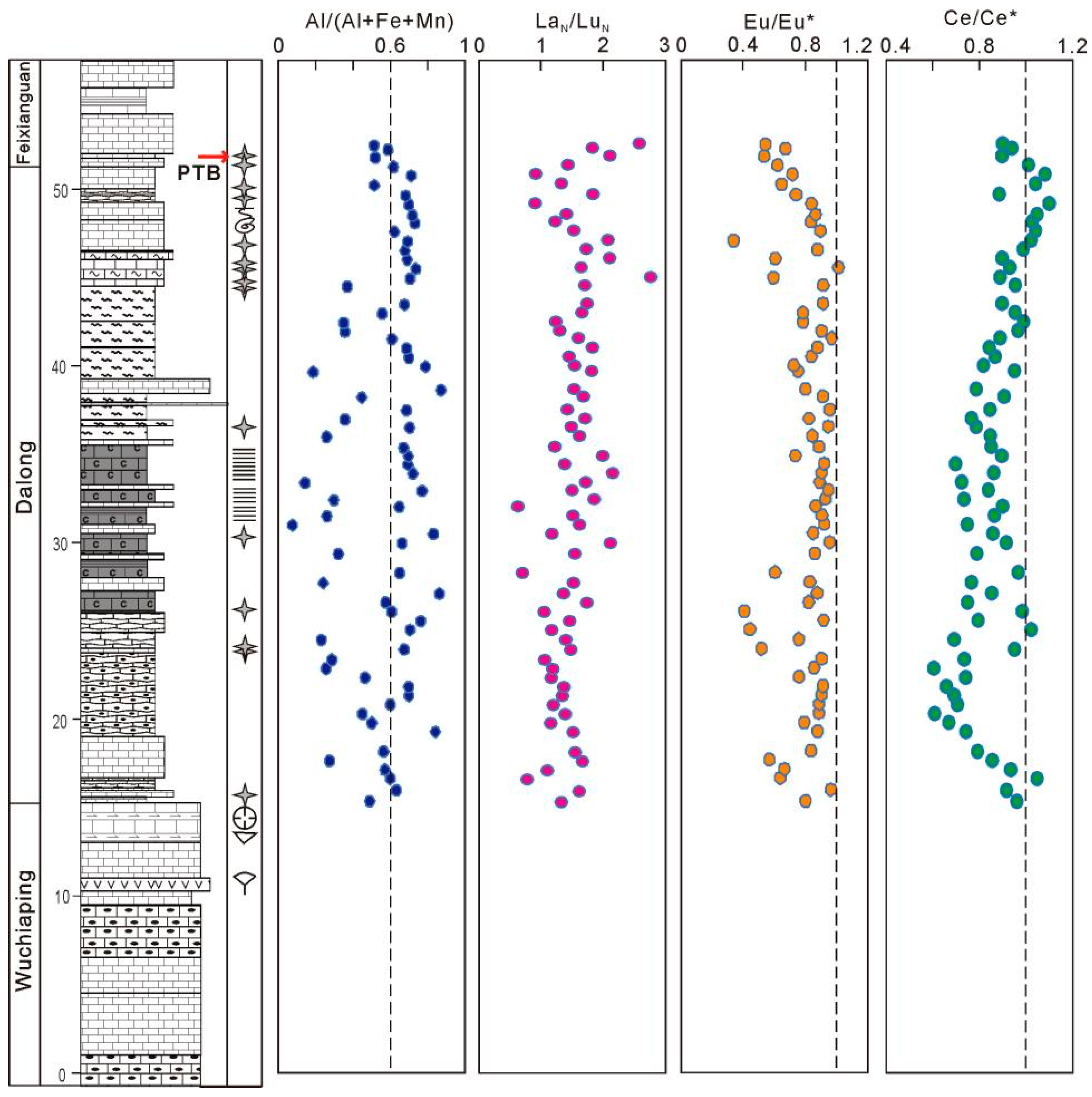

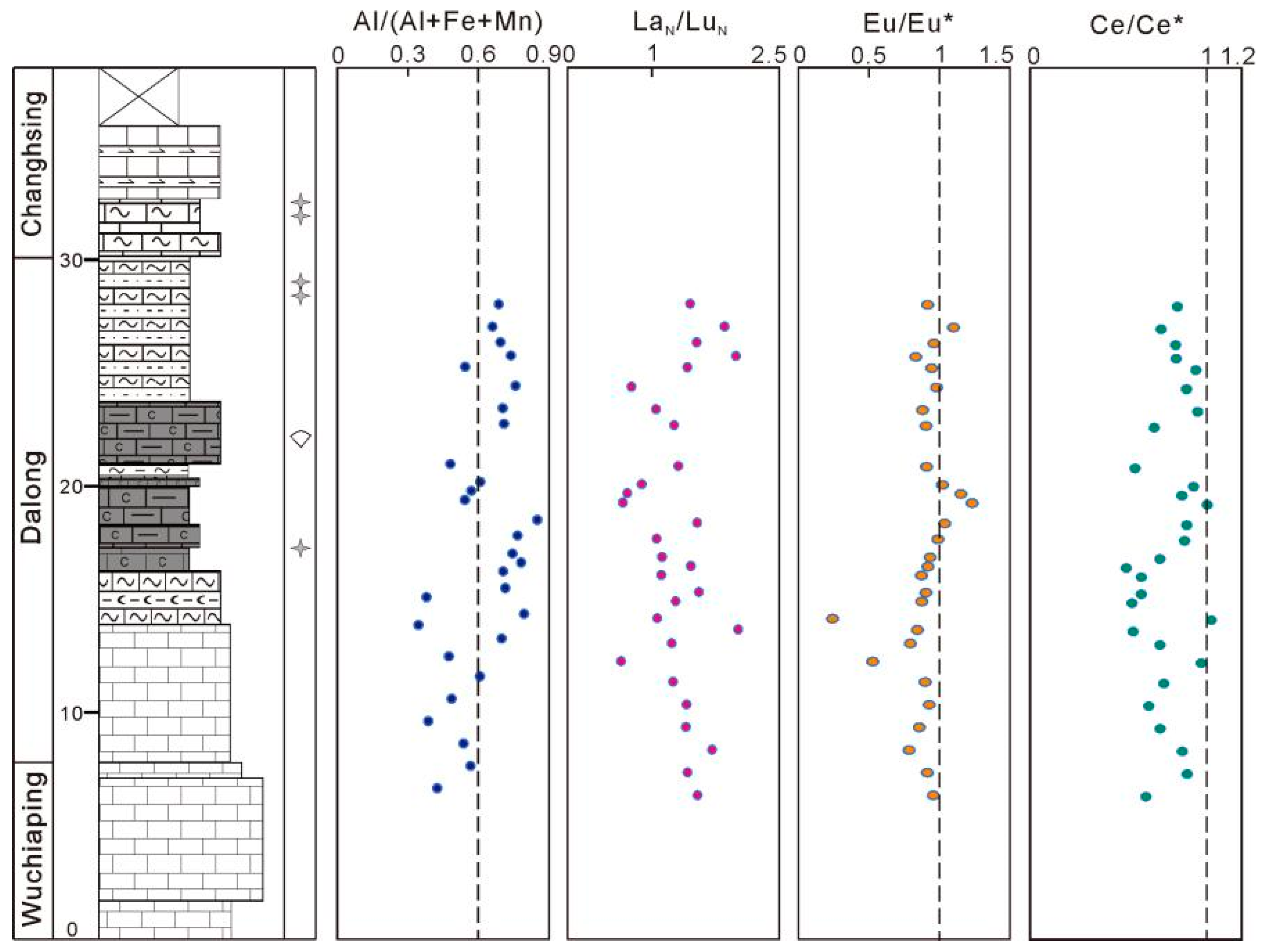
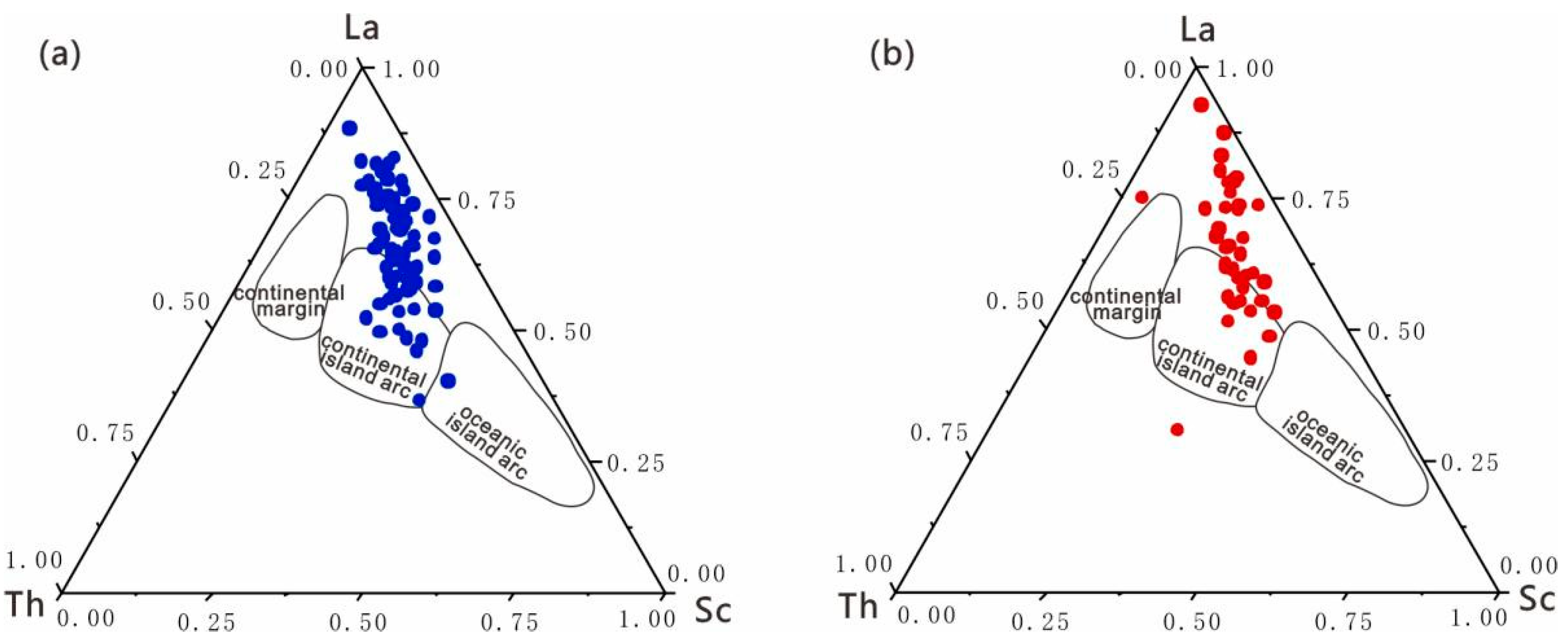
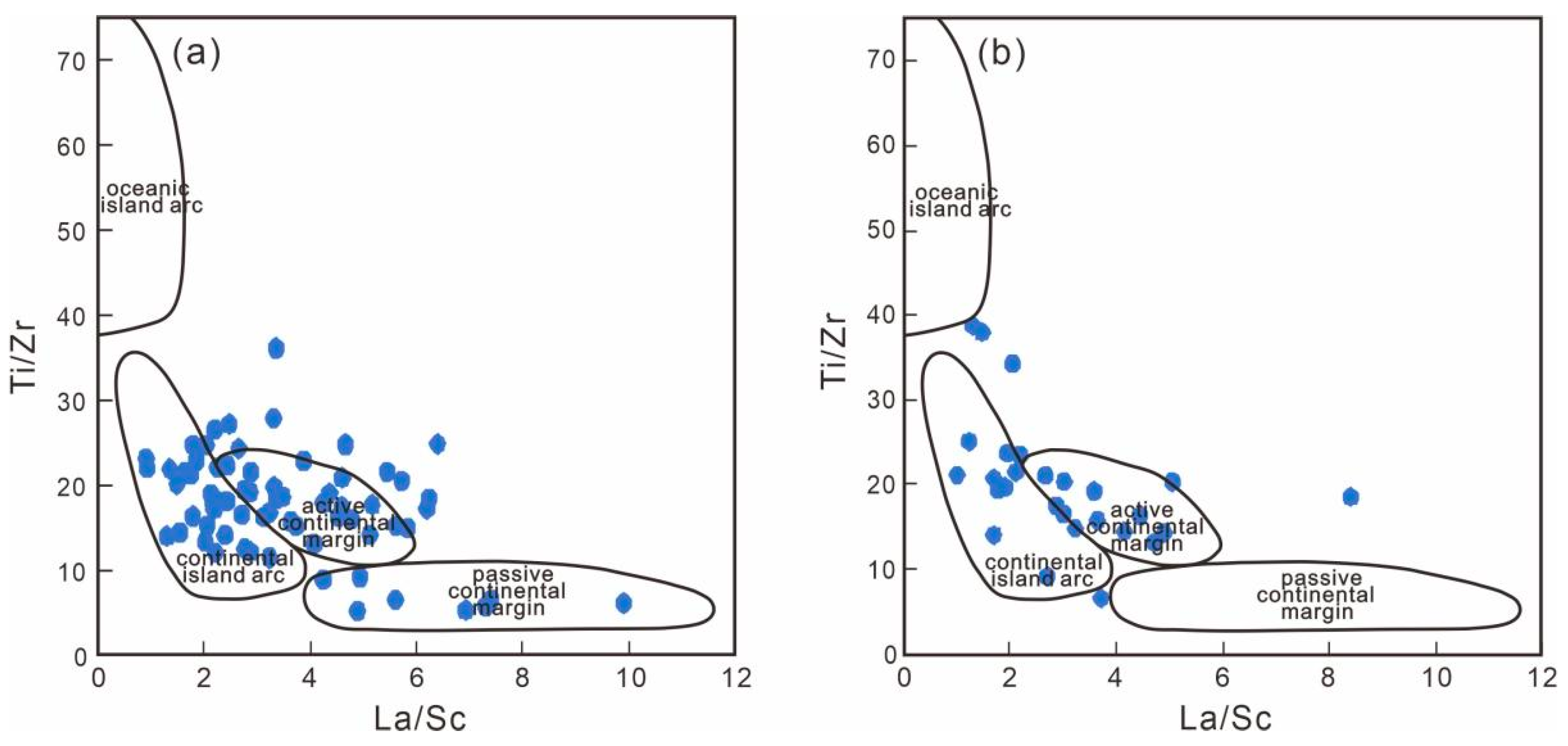

Disclaimer/Publisher’s Note: The statements, opinions and data contained in all publications are solely those of the individual author(s) and contributor(s) and not of MDPI and/or the editor(s). MDPI and/or the editor(s) disclaim responsibility for any injury to people or property resulting from any ideas, methods, instructions or products referred to in the content. |
© 2025 by the authors. Licensee MDPI, Basel, Switzerland. This article is an open access article distributed under the terms and conditions of the Creative Commons Attribution (CC BY) license (https://creativecommons.org/licenses/by/4.0/).
Share and Cite
Ge, X.; Ge, X.; Chen, D.; Liu, Y.; Wang, R.; Li, M. The Source and Significance of Silicon in the Late Permian Dalong Formation, Northeastern Sichuan Basin. Minerals 2025, 15, 69. https://doi.org/10.3390/min15010069
Ge X, Ge X, Chen D, Liu Y, Wang R, Li M. The Source and Significance of Silicon in the Late Permian Dalong Formation, Northeastern Sichuan Basin. Minerals. 2025; 15(1):69. https://doi.org/10.3390/min15010069
Chicago/Turabian StyleGe, Xiaotong, Xun Ge, Daizhao Chen, Yali Liu, Ruyue Wang, and Min Li. 2025. "The Source and Significance of Silicon in the Late Permian Dalong Formation, Northeastern Sichuan Basin" Minerals 15, no. 1: 69. https://doi.org/10.3390/min15010069
APA StyleGe, X., Ge, X., Chen, D., Liu, Y., Wang, R., & Li, M. (2025). The Source and Significance of Silicon in the Late Permian Dalong Formation, Northeastern Sichuan Basin. Minerals, 15(1), 69. https://doi.org/10.3390/min15010069






